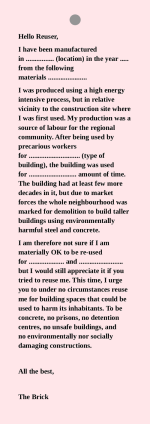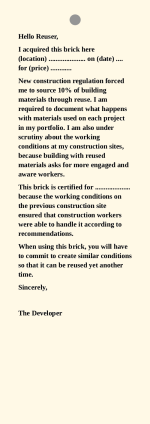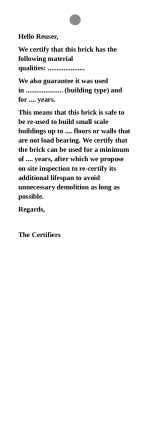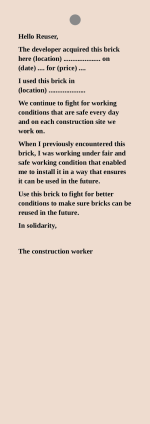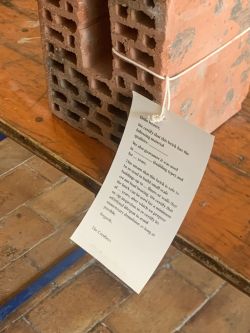P-Prompt: Certifying bricks: Difference between revisions
No edit summary |
|||
| Line 73: | Line 73: | ||
The Certifiers | The Certifiers | ||
[[File:Brick.jpg|Brick.jpg|250px|An industrial red hollow brick with a label attached on it with string]] | |||
=== Certifying bricks: A conversation === | === Certifying bricks: A conversation === | ||
Revision as of 08:55, 24 July 2024
Prompt: Certifying bricks
This prompt emerged during a conversation with author, friend and architect Dubravka Sekulić. She proposed us to think with the certification processes of recycling materials, and more specifically with bricks, as a way to ask questions about agencies, processes, relations and positions involved in reuse.
Everyone speaks about reuse all the time but what does it actually mean concretely? What relations does it set up and which ones does it transform?
Download labels for printing (PDF)
Hello Reuser,
I have been manufactured in ................ (location) in the year .................... from the following materials ............................
I was produced using a high energy intensive process, but in relative vicinity to the construction site where I was first used. My production was a source of labour for the regional community. After being used by precarious workers for ............................. (type of building), the building was used for ........................... amount of time. The building had at least few more decades in it, but due to market forces the whole neighbourhood was marked for demolition to build taller buildings using environmentally harmful steel and concrete.
I am therefore not sure if I am materially OK to be re-used for .................... and ......................... but I would still appreciate it if you tried to reuse me. This time, I urge you to under no circumstances reuse me for building spaces that could be used to harm its inhabitants. To be concrete, no prisons, no detention centres, no unsafe buildings, and no environmentally nor socially damaging constructions.
All the best,
The Brick
Hello Reuser,
I acquired this brick here (location) ..................... on (date) .... for (price) ............
New construction regulation forced me to source 10% of building materials through reuse. I am required to document what happens with materials used on each project in my portfolio. I am also under scrutiny about the working conditions at my construction sites, because building with reused materials asks for more engaged and aware workers.
This brick is certified for .................... because the working conditions on the previous construction site ensured that construction workers were able to handle it according to recommendations.
When using this brick, you will have to commit to create similar conditions so that it can be reused yet another time.
Sincerely,
The Developer
Hello Reuser,
The developer acquired this brick here (location) ..................... on (date) .... for (price) ....
I have used this brick in (location) .....................
We continue to fight for working conditions that are safe every day and on each construction site we work on.
When I previously encountered this brick, I was working under fair and safe working condition that enabled me to install it in a way that ensures it can be used in the future.
Use this brick in solidarity with our fight for better conditions to make sure bricks can be reused in the future.
Best wishes,
The construction worker
Hello Reuser,
We certify that this brick has the following material qualities: .....................
We also guarantee it was used in ..................... (building type) and for .... years.
This means that this brick is safe to be re-used to build small scale buildings up to .... floors or walls that are not load bearing. We certify that the brick can be used for a minimum of .... years, after which we propose on site inspection to re-certify its additional lifespan to avoid unnecessary demolition as long as possible.
Regards,
The Certifiers
Certifying bricks: A conversation
Dubravka Sekulić (DB): When you asked me to think about reuse, I thought about conversations in the construction industry and architecture which finally acknowledge its contribution to climate collapse. That the practice of constantly using new materials is not necessarily compatible with the big fights against climate change that they are supposedly doing... Of course, this is not complete new. Historically people have been building with reclaimed bricks, but with all the issues around insurance, performance of materials, building standards and building codes, which have been developed to protect people from buildings collapsing on their heads, it is not the same. The push in requirements to start reusing materials opened up a whole new space: what does it mean to reuse materials? What are the procedures you have to follow, not only in order to secure that you have access to this material, so that you can reuse it and make sure that not everything is thrown into a landfill. But also, how to get insurance for example, how do you get a certificate that the used steel beam will behave as expected under certain conditions?
Ideally when you buy a pile of bricks, or cladding material, you get a certificate, which tells you how this material behaves under conditions of fire or if these are structural elements, even if they are not fully or even not structural, can they hold the way they're supposed to hold? In which way they have to be installed and used in order to guarantee that they will be performing as expected? Just to make sure that you know that the building will stay safe and will not collapse
A lot of these then elements are not necessarily standard, you are kind of combining those that exist, even though these will be often standardized profiles.
I am interested in how do you write such a certificate? How can a specification go along with instructions for how to use something? You can't assume that materials can be reused exactly the same way that brand new materials can be used. So you have to give a different kind of description. A lot of this is also connected to issues of scale .... So this is really slowly shifting attitudes towards how materials are put into words, which also shifts an attitude towards how do you design because you have to then think not I'm designing something to look as if it didn't exist before, or designing with a spreadsheet that makes most money for those who are financing, but you're also here to enrich the design with materials which are there or readily available. You have to think materials in a more concrete way and all of a sudden it becomes much more important to know what actually these materials did before.
Femke Snelting (FS): Do you think this material practice of reuse maps onto authorial reuse?
DS: Maybe it is not possible to bring them together. But I thought it could be interesting to rethink what does it mean to not just use something, but to reuse it? To look into the practice of architecture and construction, and to see what are the issues that we are missing when we think about reuse of immaterial, and when we think about reusing intellectual content?
FS: Yes. What would it mean to have an authorial practice that already prefigures reuse. Where the understanding that materials were never yours to begin with, is already built into the practice that might be reused in the future.
Eva Weinmayr (EW): So I wouldn't go and buy a new brick, I would take a reused brick. And that brings all the history and the conditions and the relationships implicitly with it, it's, that's really a nice way to connect the two.
FS: In these certificates, is there also thinking about reuse that would be restricted to certain purposes? Like … do not use this brick for military purposes?
DS: I don't know. I think it's something really interesting. Can you specify that if you're demolishing council housing that you can't reuse the materials for a profit making space?
I think the certificate to certain degree assumes that you don't have contact between those who used the material before and those that are going to reuse it. It has to be something that one can trust. What becomes really interesting is that in this culture of reuse that we are thinking about, mistrust is more on the side of the second, of the reuser.
FS: This is not so different from how Free Culture licenses function. It helps when conditions for reuse are being made explicit.
DS: But there are many things that are being reused in cultural contexts that are not necessarily under a Creative Commons license? I think what I found interesting when I first encountered Creative Commons, is that it actually really starts to ask you questions that you don't necessarily would ask about your work. Does this mean that now this is not mine? Is it this? Or that? Who can reuse it? I think it made everyone to be more literate in understanding what are fair conditions? What are the questions and issues?
The analogy to what is now happening in art in architecture, is that all of a sudden, people are much more concerned actually, how is this material produced? Can I actually change it? Do I need to use something that is produced here and then has to be shipped to there or I can use... How do you frame these conditions ... how do you work with different materials and across different times and geographies. Or what groups are connected and what allows those who are negotiating to understand all the possible implications and how will they be able to interpret these relations?
London, June 2023
